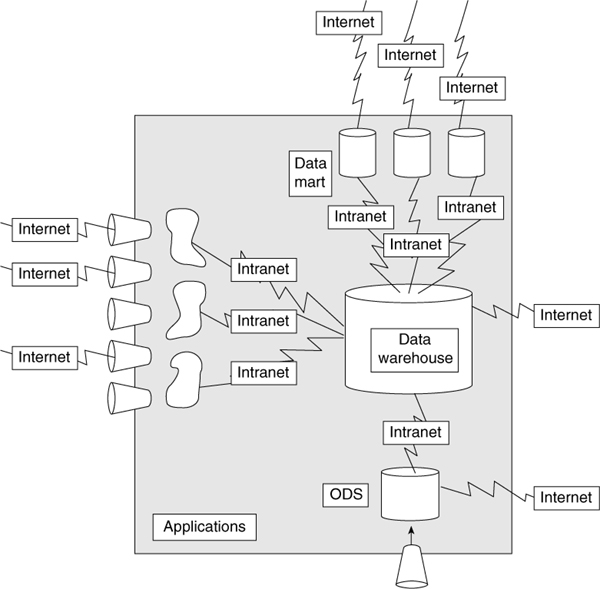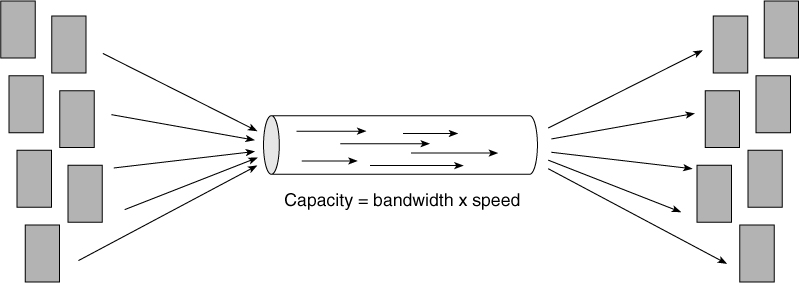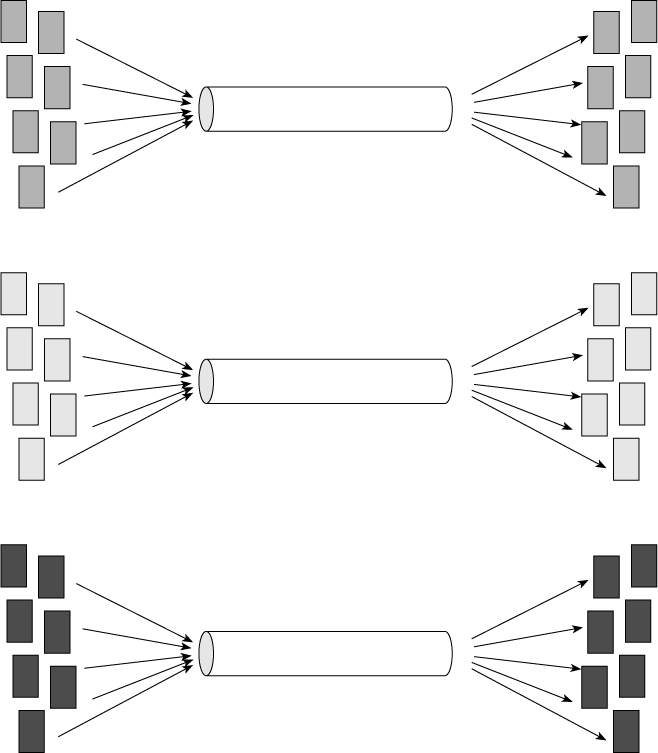CHAPTER 11
The Internet/Intranet Components
The components of the corporate information factory (CIF)—external world, applications, integration and transformation layer (I & T layer), operational data store (ODS), data warehouse, data marts, and exploration/data mining warehouse—do not stand alone. The different components of the architecture pass data in an orderly manner between themselves by means of a communications fabric. One way of thinking about this fabric is in terms of the Internet/intranet, though networks as a means to pass data actually existed long before the creation of intranets. The advent of the Internet/intranet has led to the formalization and categorization of the various types of intercommunications among the different architectural entities.
The Internet/intranet—from the perspective of the CIF—is the line of communication along which data flows and the different components interact with each other. Figure 11.1 shows that the Internet/intranet handles those communications that occur within the confines of the CIF.
The purpose of this communications fabric is to:
![]() Transport data
Transport data
![]() Distribute processing
Distribute processing

Figure 11.1 The different kinds of transmissions within the CIF.
![]() Schedule and coordinate activities
Schedule and coordinate activities
![]() Deliver status within the architecture
Deliver status within the architecture
![]() Provide architectural connectivity
Provide architectural connectivity
![]() Expose CIF capabilities to the external world
Expose CIF capabilities to the external world
Issues of Communication
The communications between the different components of the CIF are governed by many factors:
![]() Volume and speed of data
Volume and speed of data
![]() Capacity of network
Capacity of network
![]() Mode of transport
Mode of transport
![]() Cost of telecommunication lines
Cost of telecommunication lines
![]() Nature of the transport
Nature of the transport
![]() Availability of the fabric
Availability of the fabric
Volume of Data
The first consideration is the volume of data that can be passed through the communications fabric, as shown in Figure 11.2.
The volume of data that must be pushed through the intranet is of great concern in the CIF because of the amount of data that is found there. The data warehouse, in particular, contains huge volumes of data that have passed from the applications or the ODS environment. In considering the proper technology for the communications fabric, the architect must first keep in mind the massive amount of data that must pass through the environment, and the people and processes that drive the movement of data.
Speed of Data
The second consideration is the speed with which data will pass through the intranet. Figure 11.3 shows that the speed of transmission is important, because of the ODS (that is, Class I ODS) and the need to accommodate the regular flow of massive amounts of data.

Figure 11.2 The volume of data to be transmitted–bandwidth–is the first parameter of interest to the CIF architect.

Figure 11.3 The speed of transmission is the second parameter of interest to the CIF architect.

Figure 11.4 Line capacity is the third parameter of interest to the CIF architect.
Capacity of the Network
Figure 11.4 shows that network capacity for the intranet is another concern. When the rate of data flow and the volume of data are in tandem with each other, the result is the capacity of the network.
Mode of Transport
Although capacity is a primary concern, it is not the only consideration in the overall architecture. The mode of transport is also a concern. Some communications are of a bulk type and other transmissions are of a burst type. Figure 11.5 shows these different types of transmissions.

Figure 11.5 Some types of lines are geared for short bursts of activity; other lines are geared for bulk transmissions.
A bulk type of transmission is one where large amounts of data are transmitted all at once. The communications fabric is loaded and tied up for a lengthy amount of time as long transmissions of many bytes flow in all at once.
The burst kind of transmission is fundamentally different; in this type, many short transmissions are made. The types of technologies employed to support these different types of transmissions across the communication fabric are quite distinct.
Cost of Telecommunication Lines
Cost is another factor the architect must take into consideration. Figure 11.6 shows that the cost of telecommunication lines is a function of capacity and line type. An organization can always satisfy the needs for capacity if it is willing to spend enough. The trick is to satisfy the communications needs of the company and to do so economically.
Nature of the Transport
Another consideration of the intranet technology is the nature of the transport. Some transport technologies are very effective at transmitting bulk amounts of data but are relatively expensive, difficult to set up, and difficult to maintain. Some of the more popular networks of this type are Asynchronous Transfer Mode (ATM), Fiber Distributed Data Interface (FDDI), HPPI, and Fiber. Alternatively, other networks are very good at managing burst volumes and are relatively inexpensive, easy to set up, and easy to maintain. The most popular network type in this category is Ethernet. As your solution evolves, you are likely to find a combination of these transport technologies will make up your communication fabric. The final mix will be based on your needs and the cost and maturity of the transport technology. Figure 11.7 shows that some transport technologies are suitable for burst transmissions, while others are geared for bulk transmissions.

Figure 11.6 Cost of transmission infrastructure.
Availability of the Fabric
A final concern of the architect is the hours of availability of the communications fabric. Figure 11.8 depicts this issue.
All of the issues must be taken into account by the architect who is in charge of weaving together the different components of the CIF.
Who Uses the Communications Facilities?
One of the interesting ways to understand the needs of communications facilities inside and outside the CIF is in terms of who the end users are. Figure 11.9 shows who the different users of communications facilities are.
Direct and indirect customers are the users of the communications facilities as the data enters the CIF applications. Once the data enters the CIF, the next set of users consists of farmers and explorers. As data passes out of the CIF (or into the CIF from nondirect facilities), the end users are tourists.

Figure 11.7 Different transport technologies are optimized to support different transmission needs.

Figure 11.8 The hours of availability are yet another concern of the CIF architect.

Figure 11.9 Different users are scattered over the landscape.
Tourists, farmers, explorers, and direct users have very different expectations when it comes to communications:
![]() Direct customers. Expect very fast, short bursts where the response time is immediate, with very few massive bulk transmissions.
Direct customers. Expect very fast, short bursts where the response time is immediate, with very few massive bulk transmissions.
![]() Farmers. Expect short, fast bursts where the response time is generally good. In some cases, a fair amount of data transmission is needed.
Farmers. Expect short, fast bursts where the response time is generally good. In some cases, a fair amount of data transmission is needed.
![]() Explorers. Expect very infrequent transmissions of large amounts of data.
Explorers. Expect very infrequent transmissions of large amounts of data.
![]() Tourists. Expect sporadic transmissions of large and small amounts of data from a wide variety of sources.
Tourists. Expect sporadic transmissions of large and small amounts of data from a wide variety of sources.

Figure 11.10 The different types of facilities are contained in the communications fabric.
Fortunately, the different classes of users are separated, and there is little overlap in the type of communications facility that is required. Figure 11.10 shows the different types of communications facilities that are required across the CIF.
A categorization of the different characteristics of the communications technologies is shown in Table 11.1.
Communication outside the CIF is accomplished by means of the Internet, as shown in Figure 11.11. Essentially, two types of transmissions are made here:
Transmissions between one CIF and another CIF
Transmission from a CIF to a Web site
Each of these types of transmissions has its own set of characteristics.
A CIF-to-CIF transmission may be one where one corporation is communicating with another corporation, or one where two parts of the same corporation are communicating, but each part is served by different CIFs.
Table 11.1 Characteristics of Communications Facilities
|
SPEED |
VOLUME |
CAPACITY |
FACILITY TYPE |
1. Entry into applications |
high |
moderate |
moderate |
burst |
2. Applications to I & T |
high |
high |
very high |
bulk |
3. I & T to DW |
high |
high |
very high |
bulk |
4. I & T to ODS |
very high |
low |
high |
burst |
5. ODS to DSS |
low |
low |
low |
bulk & burst |
6. DW to DSS |
low |
low |
low |
bulk |
7. Data mart to DSS |
very low |
very low |
very low |
burst |
8. DW to data mart |
low |
moderate/low |
moderate/low |
bulk |
9. ODS to DW |
low |
moderate/low |
low |
bulk |
10. Internet |
low |
low |
low |
burst |

Figure 11.11 The Internet connections.
Summary
The communications between the different components of the CIF are accomplished by means of Internet/intranet transmissions. Intranet transmissions are those that occur within the CIF versus Internet transmissions that occur from/to the CIF and other external agencies. Some of the architectural issues are:
![]() Volume of data to be transported
Volume of data to be transported
![]() Capacity of networks
Capacity of networks
![]() Cost of telecommunications lines
Cost of telecommunications lines
![]() Nature of the transport
Nature of the transport
![]() Availability of the fabric
Availability of the fabric
Different types of users have different transmission needs. Farmers are found in the data marts, the data warehouse, and ODS; explorers are found in the data warehouse and occasionally in the ODS; and tourists are found on the Internet.
We have now covered all aspects of the corporate information factory necessary to give end users visibility into the data. However, this is not enough. The data lacks legibility to all but the most experienced end users. A final component is needed that describes the data in terms of definition, structure, content, and use. This component of the corporate information factory is the metadata and will be discussed in the next chapter.
